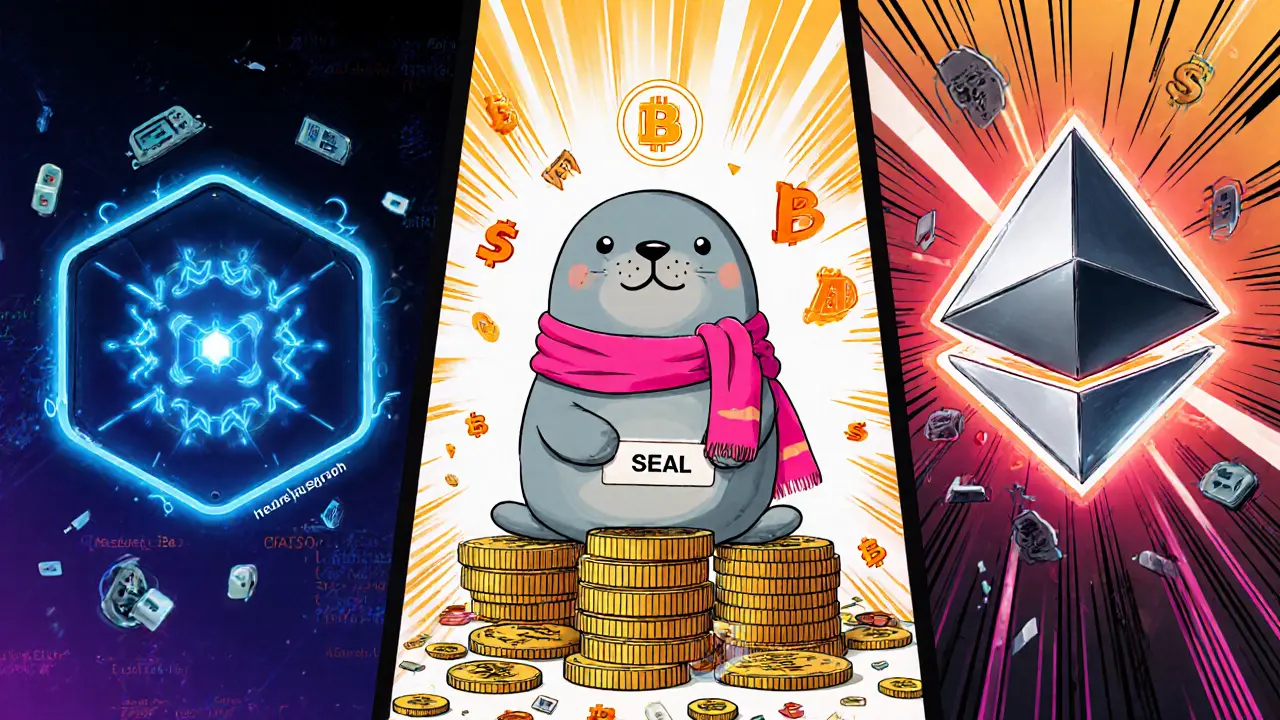SEAL Crypto Coin Identifier
SEALCOIN (IoT)
Hedera Hashgraph
Token: QAIT
Use Case: IoT Data & Energy Trading
Market Cap: ~$12M
Seal Meme Coin
Solana
Token: SEAL
Use Case: Community Memes & Charity
Market Cap: ~$71K
Seal Network (ICO)
Ethereum (ERC-20)
Token: SEAL
Use Case: General Utility Token
Market Cap: ~$24K
When you type "Seal" into a crypto tracker you’ll see three very different projects fighting over the same ticker. Seal (SEAL) is a label that currently refers to a handful of unrelated tokens - an enterprise‑grade IoT platform, a Solana‑based meme coin, and an old 2018 ICO project. Confusing, right? This guide breaks down each version, shows how they differ technically, and points out the biggest risks before you decide whether to keep an eye on any of them.
TL;DR - Quick Takeaways
- Three distinct SEAL projects: SEALCOIN (IoT), Seal meme coin (Solana), Seal Network (2018 ICO).
- SEALCOIN runs on Hedera Hashgraph, uses post‑quantum cryptography, and targets energy, agriculture, logistics.
- Meme‑coin SEAL lives on Solana, has a 999,990‑token supply, and a market cap around $71K.
- Seal Network’s ICO raised $8.7M but now trades near $0.0001 with a rank >40,000.
- Investors should match their risk appetite: enterprise tech vs community hype vs legacy project.
What is SEALCOIN? The Enterprise IoT Token
SEALCOIN is a decentralized platform designed for machine‑to‑machine (M2M) transactions. It leverages the Hedera Hashgraph ledger for sub‑second finality and combines it with post‑quantum cryptography to protect data against future quantum attacks.
The native utility token is called QAIT (Quantum AI Transactions). QAIT serves two purposes: it pays for transaction fees and it grants holders voting rights in the platform’s Proof‑of‑Security (PoSy) consensus. In practice, a sensor on a solar panel can sell excess kilowatt‑hours directly to a neighbor’s smart meter, with the payment settled automatically in QAIT.
Key industries SEALCOIN targets:
- Energy trading - real‑time micro‑grid settlements.
- Agriculture - verified telemetry from soil‑moisture sensors.
- Logistics - autonomous freight‑container handoffs.
Because the platform acts as a cross‑chain data oracle, developers can pull verified IoT data into Ethereum, Binance Smart Chain, or any other EVM‑compatible network.
Seal Meme Coin - Community‑Driven Fun on Solana
The second incarnation of SEAL is a pure Seal meme coin. It lives on the Solana blockchain, using the contract address Ho6wN4ff7RdTdXE1UsCZjrjuFVMHyRFTv1oBdbSECnJS. With a total supply of 999,990 SEAL and a circulating supply of about 981,850, the token’s slogan is “CHILL WITH SEAL”.
Trading volume hovers around $25‑$75K per day, and the market cap is roughly $71K. The coin’s value proposition is the community itself - holders can vote on charitable donations, meme contests, and occasional airdrops. There’s no technical novelty beyond Solana’s fast, low‑fee architecture.
Typical use‑cases include:
- Social media tipping for meme creators.
- Micro‑donations to wildlife charities.
- Speculative trading driven by hype cycles.
Because it’s a meme token, price swings can be extreme; a single tweet could double the price in minutes, or a coordinated sell‑off could wipe out most of the market cap in hours.
Seal Network - The 2018 ICO Relic
The third SEAL project, Seal Network, launched an ICO on May132018 and raised $8.685million over two weeks. Its token peaked at $0.000108 and now sits around the $0.00002 mark, ranking #41,719 by market cap.
Technical details are sparse. The original whitepaper hinted at a generic ERC‑20 token with basic smart‑contract functionality, but there has been little development activity reported in the past two years. The community appears dormant, and most exchanges have delisted the token.
For investors, the biggest red flag is the lack of a clear roadmap or recent code commits. Unless you enjoy hunting for hidden value in forgotten projects, this version of SEAL is best treated as a cautionary tale.

Side‑by‑Side Comparison
| Attribute | SEALCOIN (IoT) | Seal Meme Coin | Seal Network (ICO) |
|---|---|---|---|
| Blockchain | Hedera Hashgraph | Solana | Ethereum (ERC‑20) |
| Native Token | QAIT | SEAL | SEAL |
| Supply | Dynamic (governance‑regulated) | 999,990 | 21M (fixed) |
| Use Case | IoT data & energy trading | Community memes & charity | General utility token |
| Market Cap (Oct2025) | ~$12M (estimated) | ~$71K | ~$24K |
| Development Activity | Active (whitepaper, docs, partnerships) | Moderate (social media drives) | Minimal / dormant |
| Key Tech | Post‑quantum crypto, PoSy consensus | Fast Solana transactions | Standard ERC‑20 |
Investment Risks for Each SEAL Variant
Seal crypto can mean very different risk profiles depending on which token you eye.
- SEALCOIN: The biggest upside comes from enterprises adopting IoT‑enabled micro‑economies. However, the platform’s success hinges on Hedera Hashgraph gaining broader industry acceptance and on the QAIT token being adopted as a payment bridge. Regulatory scrutiny of data‑oriented blockchains could also impact growth.
- Seal meme coin: Volatility is the norm. Low market cap means liquidity can dry up quickly, and price manipulation is common. The only defensive factor is its community‑driven charitable angle, which can sometimes cushion sentiment during market dips.
- Seal Network: With almost no recent code updates and a tiny market cap, the token resembles a dead asset. The chance of a resurgence is low unless a new team revives it with fresh funding.
How to Do Proper Due Diligence
Because the ticker is shared, start with these steps before buying:
- Check the contract address on a block explorer (e.g., Hedera Mirror Node for SEALCOIN, Solscan for the meme token).
- Read the latest whitepaper or community docs - SEALCOIN’s repo shows monthly commits; the meme coin only has a Telegram file.
- Verify the development team’s LinkedIn or GitHub profiles. SEALCOIN lists several PhDs in cryptography; the meme coin lists only usernames.
- Look at on‑chain metrics: transaction volume, active addresses, and token holder distribution. A healthy IoT platform will have dozens of enterprise wallets, while a meme token will show many small wallets.
- Assess regulatory compliance - Hedera is CAC‑certified in several jurisdictions, whereas Solana‑based meme tokens often lack KYC procedures.
Future Outlook - Where Might Each Project Go?
SEALCOIN could become a backbone for decentralized energy markets if major utilities pilot its protocol. The post‑quantum encryption layer gives it a future‑proof edge, but adoption will be slow and require partnerships with hardware manufacturers.
The Seal meme coin will likely follow the typical meme‑coin cycle: a few weeks of hype, a modest peak, then a long tail of low‑volume trades. Unless a celebrity endorsement spikes interest, its market cap may stay under $200K.
For Seal Network, the most realistic scenario is eventual delisting unless a new developer team resurrects the codebase. Investors holding it now should treat it as a speculative “trash‑talk” asset.
Quick Checklist Before You Trade
- Identify which SEAL token you’re looking at (Hedera vs Solana vs ERC‑20).
- Confirm the contract address matches the token you intend to buy.
- Read the most recent technical documentation - at least one update in the last 3months indicates active development.
- Evaluate liquidity: look at 24‑hour volume >$50K for meaningful price movement.
- Match your risk tolerance: enterprise tech vs meme hype vs legacy token.

Frequently Asked Questions
What does the SEAL ticker actually represent?
The SEAL ticker is shared by three unrelated projects: SEALCOIN (an IoT platform on Hedera Hashgraph), Seal meme coin (a community token on Solana), and Seal Network (a 2018 ICO token on Ethereum). You need to check the blockchain and contract address to know which one you’re dealing with.
Is SEALCOIN a good long‑term investment?
It could be, but only if Hedera Hashgraph gains enterprise traction and QAIT becomes a widely accepted payment method for IoT data. Expect higher volatility and regulatory scrutiny compared to classic cryptocurrencies.
How risky is the Seal meme coin?
Very risky. With a market cap of about $71K and trading volume under $100K, price swings are extreme and liquidity can disappear quickly. It’s mainly for people who enjoy community hype and short‑term speculation.
Should I buy the original Seal Network token?
Probably not. Development appears dormant, the token trades near $0.00002, and there’s no clear roadmap. It’s more of a collector’s item than an investment.
Where can I find the official SEALCOIN documentation?
Visit the SEALCOIN website’s ‘Resources’ section or its GitHub repository, which hosts the whitepaper, API specs, and regular developer updates.


18 Responses
When you see a SEAL token on an explorer, the first thing to do is double‑check the blockchain and the contract address; it saves a lot of head‑ache later on, especially with three projects sharing the same ticker. Also, keep an eye on the community channels, they often post updates about which network they’re on. If you’re not sure, a quick look at the token’s logo can also give a clue – the Hedera version usually has a distinct seal graphic.
Wow, another meme coin that promises “community love” while the only thing it really loves is a quick pump‑and‑dump. If you’re hoping the Solana SEAL will magically become the next Bitcoin, you might want to adjust your expectations – or your reality.
For anyone looking into SEALCOIN, start by reviewing the Hedera whitepaper and the recent partnership announcements. Those give a concrete sense of the real‑world use cases beyond the hype.
The three SEAL tokens each serve a different purpose, so it’s key to match your risk appetite with the right one. The Hedera project targets enterprises, the Solana token is pure meme fun, and the old ERC‑20 version is mostly a relic.
Here’s a quick checklist: 1) Verify the blockchain (Hedera, Solana, or Ethereum). 2) Match the contract address on the appropriate explorer. 3) Look at on‑chain metrics – transaction volume and active addresses give a clear picture of actual usage. 4) Review the development roadmap; active commits are a good sign. 5) Consider regulatory compliance – Hedera has more formal certifications than most meme projects.
Check the contract address before you buy.
One might observe, quite deliberately, that the very notion of “SEAL” as a symbol lends itself to philosophical contemplation; however, the practical reality remains: without proper due‑diligence, investors risk wandering into a fog of ambiguity.
Hey fam! 🌊 If you’re hunting SEAL on Solana, just remember the logo looks like a cute seal doing a wave – super easy to spot! 🦭💦
Stay curious and keep learning – you’ve got this!
Don’t get fooled by flashy memes; demand real documentation before you trust any SEAL token.
If you’re weighing the Hedera SEALCOIN, look at the partnership pipeline – real utility comes from enterprise adoption, not just hype.
Another token masquerading under the same ticker, another needless source of confusion – the crypto space would benefit from a simple naming convention.
While the meme coin may be entertaining, its market cap suggests limited upside unless a major influencer jumps on board.
It’s fascinating how a simple three‑letter ticker can become a battlefield of competing narratives, each trying to claim legitimacy while the rest of us watch the chaos unfold.
The SEALCOIN project on Hedera offers a compelling vision for decentralized IoT data markets, leveraging post‑quantum cryptography to future‑proof transaction security. Its Proof‑of‑Security consensus aims to provide sub‑second finality, which is crucial for real‑time energy trading between micro‑grids. By using the QAIT token as both a fee mechanism and a governance tool, the platform incentivizes honest data reporting from sensors. Enterprises can integrate the SEALCOIN oracle to pull verified telemetry into existing smart contracts on Ethereum or other EVM chains. This cross‑chain capability reduces data silos and opens new revenue streams for hardware manufacturers. Partnerships announced with several renewable energy firms suggest a growing adoption pipeline. Moreover, the Hedera network’s governance model, backed by institutional members, adds a layer of regulatory confidence. However, the success of SEALCOIN hinges on convincing utilities to replace legacy SCADA systems with blockchain‑enabled solutions, which is a tall order. Competition from other IoT‑focused blockchains, such as IOTA, means the race for market share is fierce. The token’s supply dynamics are governed by on‑chain votes, allowing the community to adjust inflation in response to demand. This flexibility can be advantageous but also introduces governance risk if large stakeholders collude. From a security standpoint, the integration of post‑quantum algorithms is forward‑looking, yet it may increase computational overhead on low‑power devices. Investors should therefore assess the trade‑off between security and performance. Finally, regulatory scrutiny of data‑centric blockchains could impact deployment timelines, especially in regions with strict privacy laws. In summary, SEALCOIN presents a high‑potential use case with notable technical merits, but its future is contingent on ecosystem adoption, competitive pressure, and regulatory clarity.
Oh sure, because the Solana meme token will definitely become the next global reserve currency – what could possibly go wrong?
There’s a hidden agenda behind the multiple SEAL tokens; someone’s trying to funnel capital into a secret consortium that isn’t disclosed publicly.
Reading the long analysis on SEALCOIN feels like stepping into a vivid tapestry where every thread – from the post‑quantum cryptography to the nascent partnerships with renewable energy pilots – weaves together an intricate picture of what could be a transformative layer for the IoT ecosystem. The author’s emphasis on cross‑chain data oracles paints a future where data isn’t siloed but flows freely, unlocking new business models for both small‑scale sensor manufacturers and large‑scale utility providers. In that vision, QAIT isn’t merely a utility token; it becomes the lingua franca for autonomous micro‑transactions, democratizing access to energy markets that were once the domain of massive players. One can almost hear the whispers of regulators in the background, debating whether the new data‑centric paradigm fits within existing frameworks or demands fresh legislation. Meanwhile, the competitive landscape is teeming with contenders like IOTA, Helium, and even traditional cloud providers, each jockeying for dominance in this emerging frontier. As the narrative unfolds, the astute reader can see that adoption hinges not just on technology but on the human factor – trust, governance, and the willingness of institutions to experiment. The analysis, with its balanced critique and hopeful optimism, serves as both a roadmap and a cautionary tale, urging stakeholders to tread carefully yet boldly into this promising yet uncharted terrain.